FREESKY Blogs
Stay updated with the latest news, tips, and insights on e-bikes, technology, and sustainable riding through the FREESKY blog.
There's no item in your cart.
You May Also Like
You're Saving €0,00
Shipping, taxes, and discount codes calculated at checkout.All Topics


Freesky Rocky Pro vs Cyrusher Kommoda 3.0
Aug 29, 2025 09:00
At Freesky, we are dedicated to redefining the electric bike experience through cutting-edge technology and innovative design. Our mission is to deliver an enjoyable, safe, and high-performance ride, which is exemplified by the Freesky Rocky Pro. With its robust yet sleek design, the Rocky Pro stands as a flagship of versatile e-bike engineering. Featuring advanced components, dual-certified UL batteries, and powerful motor systems, it raises the bar for what a high-end step-through e-bike can offer. Read on to see how the Rocky Pro excels when compared to one of our most asked-about competitors, the Cyrusher Kommoda 3.0, across performance, comfort, and smart features. Frame & Usage Scenario The Freesky Rocky Pro is built for both city commuting and adventure riding. Its step-through aluminum frame paired with a lightweight yet sturdy 6061 alloy design allows for easy mounting, adjustable seating for riders from 5’1” to 5’11”(155~180 cm), and superior overall stability. In contrast, the Cyrusher Kommoda 3.0 is primarily focused on city commuting, with a slightly heavier frame and a more upright riding posture. Freesky’s design versatility ensures comfort and control in a wider variety of terrains and scenarios. Weight & Build Material Both the Freesky Rocky Pro and Cyrusher Kommoda 3.0 are constructed from durable aluminum alloy. The Rocky Pro’s smart frame geometry is designed for optimized handling, providing stability and comfort across various terrains. While the overall weights of the two bikes are comparable, the Rocky Pro’s thoughtful design—including step-through frame and balanced weight distribution—makes it easy to handle and maneuver in urban environments or when lifting the bike for storage. Power & Motor The Rocky Pro is equipped with a 750W brushless motor, peak 1200W, offering 100Nm torque and top speeds up to 32 MPH. Combined with its high-performance controller, it conquers 30° slopes with ease. The Kommoda 3.0, in comparison, has a 250W motor with 85Nm torque and a maximum speed of just 15.5 MPH. Riders seeking higher performance, faster commuting, or hilly terrain will find the Rocky Pro substantially more capable. Battery & Range Freesky Rocky Pro features a 48V 25Ah Samsung battery, dual UL-certified for safety and performance, offering 45–90 miles (72-144 km) per charge. Quick charging in 6–8 hours, with a removable design, ensures riders spend more time on the road and less time waiting. Kommoda 3.0 uses a 48V 20Ah battery with a shorter range of 68 miles (110 km). Suspension & Comfort The Rocky Pro incorporates a three-shock absorber system (hydraulic front fork + dual rear spring + shock-absorbing saddle), absorbing up to 85% of bumps and vibrations. It ensures a smooth and stable ride even on uneven terrain. By comparison, Kommoda 3.0 uses oil-and-spring front suspension and a rear air shock, providing less comprehensive vibration absorption, especially on rough roads. Brakes & Safety Freesky employs 4-piston hydraulic brakes with 180mm rotors for precise, stable stopping even at high speeds. The step-through frame, adjustable seat, and robust tire system provide superior control. Kommoda 3.0 also features hydraulic brakes, but Freesky’s four-piston system gives a clear edge in safety and braking power. Riding Modes & Control Freesky Rocky Pro includes 5 riding modes: Electric, Pedal-assist, Cruise, Manual, and Walk, adjustable on the fly to match the rider’s needs. This flexibility ensures optimal control in any scenario. Kommoda 3.0 also supports multiple modes, but adjustments are more limited and less intuitive. Tires & Night Riding With CST 20"x4" fat tires and full lighting systems including turn and brake lights plus an 800-lumen headlight, Rocky Pro is optimized for safety and comfort at night and across all terrains. Kommoda 3.0, while equipped with fat tires, lacks the same level of integrated lighting. Parameter Comparison Table Feature Freesky Rocky Pro Cyrusher Kommoda 3.0 Advantage Motor 750W / Peak 1200W Brushless 250W Brushless Rear Hub Freesky Top Speed 32 MPH (≈51 km/h) 15.5 MPH (≈25 km/h) Freesky Torque 100Nm 85Nm Freesky Battery 48V 25Ah Samsung, UL 2271 & 2849 48V 20Ah Freesky Range 45–90 miles (≈72–144 km) 68 miles (≈110 km) Freesky Charging Time 6–8 hours 6–7 hours Comparable Suspension Front hydraulic + 2x rear spring + seat shock Oil & Spring front + Air rear Freesky Brakes 4-piston hydraulic, 180mm rotors Hydraulic, 180mm Freesky Riding Modes 5 (Electric, PAS, Cruise, Manual, Walk) PAS with limited modes Freesky Tires CST 20"x4" Fat Tires Arisun 20"x4" Fat Tires Comparable Smart Display HD LCD + NFC + Type-C Charging 3.7" LCD (requires phone) Freesky Adjustable Frame Step-through, 5’1”–5’11” (155~180 cm) Step-through, limited Freesky Max Load 300 lbs (≈136kg) 350 lbs (≈159kg) Kommoda (payload) Warranty 18M motor/battery/controller, 12M others Similar, battery not dual-certified Freesky Conclusion Freesky Rocky Pro outperforms Cyrusher Kommoda 3.0 in motor power, top speed, battery capacity, suspension, brakes, and riding versatility, while remaining user-friendly and reliable. For riders seeking a high-performance, safe, and technologically advanced e-bike for commuting, leisure, or adventure, Rocky Pro is the clear choice. Experience the future of riding with Freesky Rocky Pro—where performance, safety, and innovation meet.
Read More

Freesky Ranger vs. Cyrusher Ranger: Powerful Fat Tire E-Bikes Compared
Aug 22, 2025 09:00
When it comes to fat tire e-bikes, riders want a combination of power, range, and safety, all at a fair price. Freesky Ranger and Cyrusher Ranger are both capable fat bikes, but they cater to slightly different needs. Let’s break down how each one performs—and where value meets capability. Design Philosophy: Dual Power vs. Urban Comfort Freesky Ranger – Strong, Reliable, and Safe(New Edition)Equipped with dual hub motors delivering 200 Nm torque, Freesky Ranger balances strong acceleration with controllable handling. Its full hydraulic 4-piston disc brakes, fat tires, and robust 6061 aluminum frame ensure short stopping distance and high stability across hills, wet roads, and light off-road paths. Cyrusher Ranger – Practical and EfficientWith a 250W rear hub motor and torque sensor, Cyrusher Ranger is optimized for city roads, commuting, and light trails. 26"x4" fat tires and hydraulic brakes provide a smooth, predictable ride, but the motor power and range are more modest compared with Freesky Ranger. Performance Comparison: Power, Torque, and Range Feature Freesky Ranger Cyrusher Ranger Motor Dual Hub Motors, 200 Nm torque 250W Rear Hub (95 N·m) Power 2OOOW Rated, 35OOW Peak 250W Battery 48V 25Ah, Removable 52V 20Ah LG, Removable Range 60–95 miles(96-152 km) 74 miles (120 km) Max Hill Climb 40° Not disclosed Brakes 4-Piston Hydraulic Disc Hydraulic 180mm Front/Rear Gear System 7-Speed Shimano 9-Speed Shimano Frame 6061 Aluminum Alloy 6061 Aluminum Alloy Riding Modes 5 Modes (Cruise, Throttle, Pedal Assist, Regular, Walk Assist) 5 Levels PAS Why It Matters: Freesky Ranger: Dual motors and 200 Nm torque provide confident acceleration and controlled climbing. Long-range 48V 25Ah battery allows 60–95 miles(96-152 km) of riding, while 4-piston hydraulic brakes ensure safe stopping on inclines or wet surfaces. Cyrusher Ranger: Reliable for commuting and light trails, with 250W motor and moderate range. Hill-climbing ability is limited and not officially disclosed. Ride Experience: Confident Handling vs. Comfortable Commuting Freesky Ranger – Powerful and Controllable High-Performance Climbing: Dual motors and strong torque make uphill riding manageable and responsive. Long-Distance Confidence: Large 25Ah battery extends ride duration for longer journeys. Safety Focus: Fat tires, full hydraulic brakes, and robust frame design offer stable, controlled riding. Ideal For: Riders who want strong power, reliable braking, and extended range for both commuting and weekend rides. Cyrusher Ranger – Urban-Friendly Ride City Commuting Comfort: Torque sensor and moderate motor support make pedaling easy. Moderate Terrain: Suitable for paved roads, light trails, and urban exploration. Ideal For: Riders seeking a comfortable, practical fat bike for everyday use. Price and Value Consideration One of the key differences is price. Freesky Ranger is approximately €1100 less expensive than Cyrusher Ranger, offering dual-motor performance, extended range, and 4-piston brakes at a more accessible cost. For riders seeking maximum power and reliable stopping performance without a high premium, Freesky Ranger presents strong value. Final Verdict: Power and Confidence or Practical Comfort? ✨ Choose Freesky Ranger if you want dual-motor power, high torque, extended range, and safety-focused braking at a competitive price. ✨ Choose Cyrusher Ranger if your rides are mostly urban or light trails, and you value comfort and moderate performance. “Both bikes offer quality fat tire experiences, but Freesky Ranger gives riders more power, range, and braking reliability for less money, while Cyrusher Ranger emphasizes ease of use and urban practicality.”
Read More
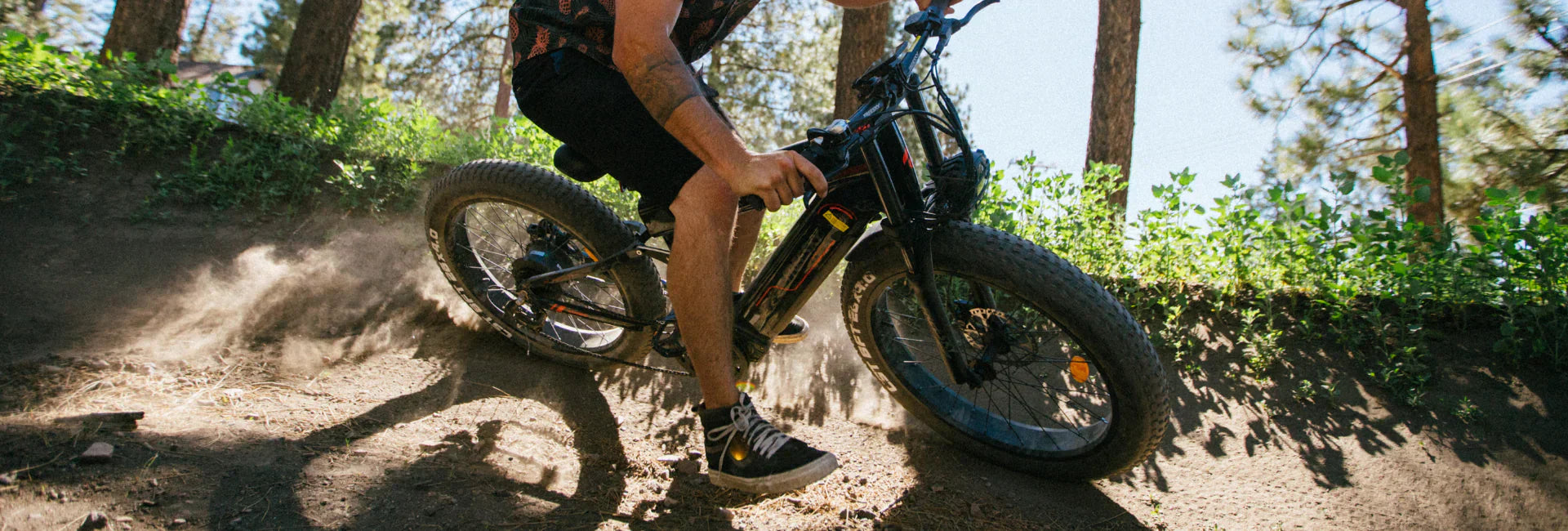
Freesky Alaska Pro vs. Cyrusher Ranger: Which Fat Tire E-Bike Suits Your Adventures?
Aug 15, 2025 09:00
Choosing the right fat tire e-bike isn’t just about specs—it’s about finding a ride that feels safe, reliable, and suited to your typical routes. Freesky Alaska Pro and Cyrusher Ranger each offer strong points, but in different riding scenarios. Design Philosophy: Safety and Versatility Freesky Alaska Pro – Powerful and StableAlaska Pro features dual removable batteries, full suspension, and 26"x4" fat tires designed for stability across varied surfaces. The aluminum frame, 4-piston hydraulic disc brakes, and responsive gear system ensure controlled rides on inclines or uneven terrain. Every component is chosen to support confidence and safety, whether you’re commuting, climbing moderate hills, or enjoying extended rides. Cyrusher Ranger – Comfortable and PracticalRanger prioritizes comfort and ease. Its 250W rear hub motor, 52V 20Ah battery, and torque sensor are optimized for city roads and light trails. Puncture-resistant tires, front suspension, and a reliable brake system ensure smooth, predictable handling in urban or moderately uneven environments. Feature Freesky Alaska Pro Cyrusher Ranger Motor 1200W Rated, 2500W Peak(130 N·m) 250W Rear Hub (95 N·m) Battery 48V 41Ah Dual (~1968Wh) 52V 20Ah LG (~1040Wh) Range 90–160+ miles(144-257 km) 74 miles (120 km) Max Hill Climb 40° Not officially disclosed Suspension Full Suspension (Lockable Hydraulic Fork + Rear Shock) Front Suspension Fork w/ Lockout Brakes 4-Piston Hydraulic Disc Hydraulic 180mm Front/Rear Gear System 7-Speed Shimano 9-Speed Shimano Payload Capacity 300 lbs 350 lbs Riding Modes 5 Modes + Pedal Assist 5 Levels PAS Ride Experience: Confidence Over Extremes Freesky Alaska Pro – Controlled Power and Endurance Reliable Climbing: 1200W rated / 2500W peak motor provides controlled assistance for hills. Long-Range Reliability: Dual batteries extend ride distance to 90–160+ miles(144-257 km). Enhanced Safety: Full suspension plus 4-piston hydraulic brakes offer stable stopping power. Ideal For: Riders seeking reliable power, long-range rides, and confident braking across a variety of surfaces. Cyrusher Ranger – Comfortable Urban Riding Smooth City Commuting: Torque sensor and 250W motor optimize pedaling efficiency. Moderate Terrain: Suitable for light trails and paved paths, not designed for steep inclines. Ideal For: Urban riders and casual weekend cyclists who prioritize comfort and predictability. Key Difference: Reliability vs. Everyday Utility Freesky Alaska Pro: Focused on strong, controllable power, long-range capability, and safety features to handle varied riding conditions with confidence. Cyrusher Ranger: Offers urban-friendly comfort, suitable for lighter terrain and moderate distances.
Read More
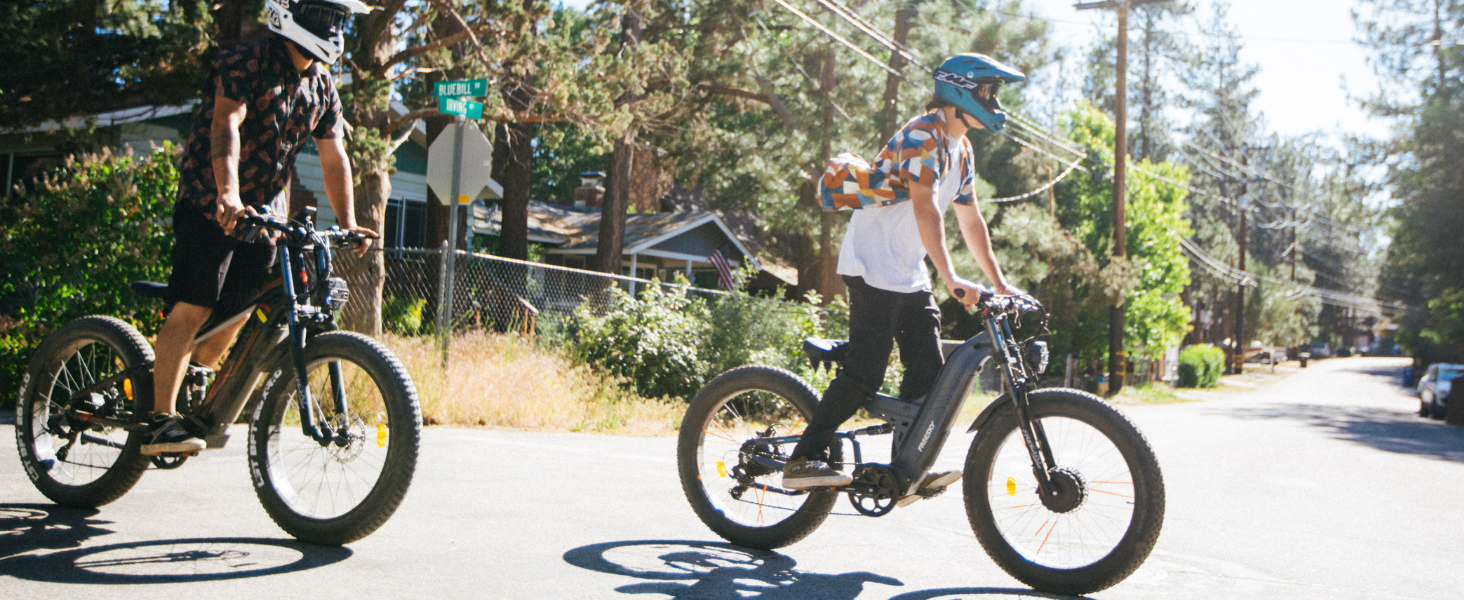
Hybrid Bike vs Electric Bike in Europe: Which One Suits Your Ride?
May 02, 2025 09:00
As cycling gains momentum across Europe, more riders are seeking the perfect bike to match their lifestyle, terrain, and commuting needs. With a wide selection available—from classic hybrids to advanced electric bikes—understanding the key differences is essential to making an informed choice. In this article, we explore the distinctions between hybrid bikes and electric bikes, their benefits, and how premium models like the Warrior Pro and Alaska Pro fit into the European cycling landscape. What is a Hybrid Bike? Hybrid bikes combine the best features of road, touring, and mountain bikes, offering versatility across mixed terrains common throughout Europe—from city streets in Amsterdam to countryside trails in Bavaria. Featuring lightweight frames, flat or slightly curved handlebars, and medium-width tyres, hybrids provide a comfortable, upright riding posture suitable for short to medium distances. Typical hybrid bikes in Europe come in several types: commuter hybrids for daily travel with racks and fenders; performance hybrids with lighter components for speed; dual-sport hybrids for light off-road use; and comfort hybrids prioritising a relaxed ride. Key Benefits: Entirely human-powered, promoting cardiovascular fitness. Affordable and low-maintenance, making them accessible for most budgets. Lightweight and agile for urban and suburban cycling. What is an Electric Bike? Electric bikes (e-bikes) in Europe are defined by an electric motor that assists pedalling up to 25 km/h with a maximum power output of 250W, complying with EU regulations (EN15194). This assistance enables riders to tackle hills, longer distances, and heavier loads with reduced physical effort. Electric bike categories include commuter e-bikes, mountain e-bikes (e-MTBs), folding e-bikes for easy storage, cargo e-bikes for transporting goods or children, and road e-bikes designed for speed and efficiency. Warrior Pro and Alaska Pro: Premium Electric Bikes for European Riders Among the many e-bike options, the Warrior Pro M-530 and Alaska Pro M-520 stand out as exceptional choices tailored for European riders seeking power, range, and versatility. Warrior Pro M-530 200Nm Dual motors deliver impressive hill-climbing power while staying within European assistance limits (power capped accordingly). Robust frame and suspension designed for all-terrain performance—from urban streets to rugged trails in the Alps. 30Ah UL certified SUMSUNG battery offering an extended range of up to 152 km, ideal for long-distance touring or daily commutes across sprawling cities like Berlin or Paris. Alaska Pro M-520 Equipped with a 130Nm motor, optimized for efficiency and smooth assistance on diverse terrains. Lightweight yet durable design suited for both urban riding and countryside excursions. Advanced Dual Battery technology delivering 90-160 miles (approx. 145-257 km) of range, reducing range anxiety on extended journeys. Both models provide European riders with enhanced convenience, eco-friendly transportation, and the freedom to explore more without exhaustion. Comparing Hybrid Bikes and Electric Bikes in Europe Feature Hybrid Bikes Electric Bikes Power Source Entirely human-powered Electric motor with pedal assistance Types Commuter, performance, comfort Commuter, folding, mountain, cargo, road Suitable Terrain Flat to moderate inclines, mixed Hills, long distances, heavy loads Speed Limited to rider effort Motor-assisted up to 25 km/h (EU legal limit) Physical Effort Higher, promotes fitness Lower, aids riders of varying fitness Cost Generally more affordable Higher due to motor and battery tech Maintenance Simple, inexpensive More complex, requires specialised care Environmental Impact Zero emissions Low emissions, especially with renewable energy Accessibility Best for physically fit riders Accessible to wider age and fitness ranges Legal Considerations in Europe E-bikes in the EU must comply with the 250W power limit and 25 km/h assist speed. Riders benefit from fewer restrictions compared to motor vehicles but should always check specific national laws as some countries regulate additional requirements like helmet use or age limits. Hybrid bikes face no such motorised vehicle regulations but require standard cycling safety practices, including helmet use, lighting, and obeying traffic laws. Why Choose a Warrior Pro or Alaska Pro in Europe? European riders looking for reliable, high-performance e-bikes will appreciate the Warrior Pro and Alaska Pro for their compliance with EU standards, extended range capabilities, and rugged build quality. Whether commuting through dense city centres or exploring Europe’s diverse natural landscapes, these models combine power and practicality, supporting eco-conscious and efficient travel. Final Thoughts: Which Bike is Right for You? Your choice ultimately depends on your personal priorities: fitness and simplicity with a hybrid, or ease and power with an electric bike. For urban commuters, hill riders, and long-distance explorers across Europe, electric bikes like the Warrior Pro and Alaska Pro present compelling options that align with modern lifestyles and sustainability goals. FAQs: Hybrid Bikes vs Electric Bikes in Europe Q: Are electric bikes legal across Europe?A: Yes, provided they meet the EU regulations of 250W maximum motor power and assist only up to 25 km/h. Q: Can hybrid bikes handle European hills?A: Hybrids are suited for gentle inclines but may be challenging on steep or prolonged hills without motor assistance. Q: Which bike offers better value for European commuters?A: Hybrid bikes are more affordable upfront and cheaper to maintain; electric bikes require higher investment but offer convenience and reduced effort. Explore our range of electric bikes including the Warrior Pro and Alaska Pro — designed for European riders seeking power, durability, and eco-friendly mobility. Start your cycling journey across Europe today! 👉 [Shop Electric Mountain Bikes Now]
Read More
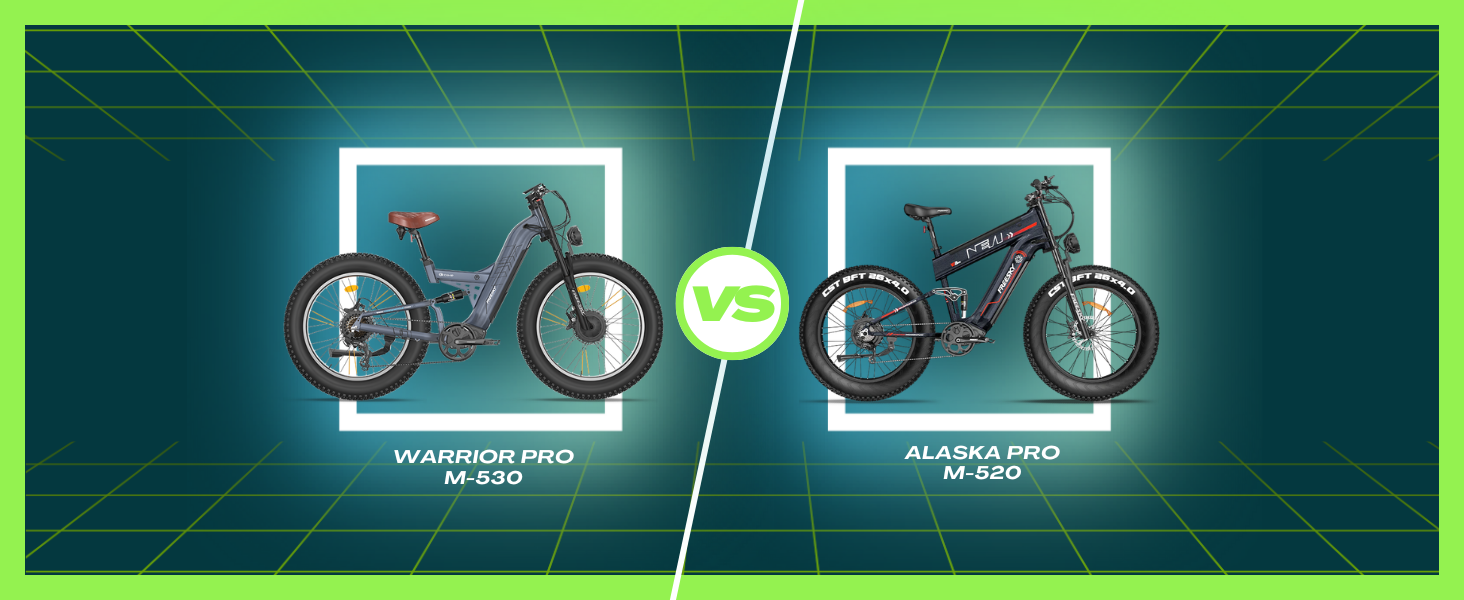
Warrior Pro vs. Alaska Pro: How to Choose the Perfect E-Mountain Bike for Your Adventure?
Apr 25, 2025 09:00
If you’re considering purchasing an electric mountain bike (E-bike) and are torn between the Alaska Pro M-520 and the Warrior Pro M-530, you’re not alone. Both models offer impressive features, performance, and quality, but they’re designed with slightly different riders and riding conditions in mind. Whether you're new to the world of electric bikes or an experienced rider, understanding the key differences between these two models will help you choose the one that best suits your needs. 1. Power & Performance: Dual Battery vs. Dual Motor Warrior Pro M-530:The Warrior Pro is all about raw power and performance. Equipped with dual motors, it provides an outstanding amount of torque, making it perfect for challenging terrain and steep inclines. With its 200Nm of combined torque, this bike delivers exceptional climbing capabilities, making it ideal for riders who prioritize power and want to conquer the toughest trails, no matter the gradient. Alaska Pro M-520:The Alaska Pro, on the other hand, is powered by a single motor paired with a dual battery system, which focuses more on range than pure performance. With 130Nm of torque, it still offers plenty of power for standard trails, but its primary strength lies in its impressive range of up to 257 kilometers on a single charge. If you’re looking to cover long distances with minimal concern about recharging, the Alaska Pro is the better option. Which to choose? Choose the Warrior Pro if you’re an adventurous rider looking for the maximum power to handle steep hills, rough terrain, and long off-road rides. The dual motors provide ample performance for any challenging conditions. Choose the Alaska Pro if you want to cover longer distances without needing to charge frequently, especially for all-day rides. Its dual battery system is the perfect solution for long-range riders. 2. Battery Life: How Far Can You Go? Warrior Pro M-530:The Warrior Pro comes with a 48V 30Ah SAMSUNG battery, providing a range of 96-152 kilometers on a single charge. This is perfect for most off-road adventures, but depending on the terrain and riding conditions, it may need a recharge for extended trips. Alaska Pro M-520:The Alaska Pro, thanks to its dual battery system (48V 41Ah), boasts an impressive 144-257 kilometers range on a single charge. This makes it the ideal choice for riders looking for long-distance adventures or those using their bike for daily commuting without worrying about running out of power. Which to choose? Choose the Alaska Pro if long range is your priority. Whether you’re commuting or planning long outdoor trips, the dual battery system will give you peace of mind, covering hundreds of kilometers. Choose the Warrior Pro if you’re more focused on power and performance than distance and are okay with recharging after longer rides. 3. Suspension & Comfort: Smooth Ride for Any Terrain Warrior Pro M-530:The Warrior Pro features a dual suspension setup with a lockable front hydraulic downhill fork and rear suspension, providing excellent shock absorption on rocky trails and downhill rides. It is designed for riders who need greater control and comfort on rougher terrains. Alaska Pro M-520:The Alaska Pro also features dual suspension but with an adjustable front suspension fork for tailored comfort. Its design allows for smoother riding on varying surfaces such as light gravel or paved roads, making it a great option for both off-road and urban commuting. Which to choose? Choose the Warrior Pro if you plan on tackling rough, rocky trails or downhill paths. Its suspension system will provide maximum comfort and control on challenging surfaces. Choose the Alaska Pro if you prefer a smoother, more adjustable ride for a mix of terrains, whether it’s rough trails or light gravel, and want more comfort on longer rides. 4. Braking System: Stopping Power Warrior Pro M-530 & Alaska Pro M-520:Both e-bikes are equipped with 4-piston hydraulic disc brakes, offering exceptional braking control. This powerful brake system ensures rapid and safe stops, even at high speeds or on rough terrains. Whether you're descending a steep slope or navigating challenging off-road trails, the braking system on both models provides smooth and reliable stopping power. With both the Warrior Pro and Alaska Pro sharing the same 4-piston hydraulic disc brakes, the braking performance is identical across both models, ensuring riders can confidently handle any riding conditions—be it mountainous trails or urban streets. This high-performance braking system delivers the necessary safety and control for adventurous mountain biking as well as commuting in the city. Which to choose? Whether you choose the Warrior Pro or the Alaska Pro, both come with the same 4-piston hydraulic disc brakes, offering superior braking performance. If you’re looking for an e-bike that can provide quick, efficient stops on rugged terrains or city roads, both options will serve you well, ensuring you stay in control in every riding scenario. 5. Who Should Choose Each Model? Choose the Warrior Pro if: You want a bike that offers maximum power for climbing steep hills and rough terrain. You plan on riding challenging trails or mountainous areas that demand excellent braking and suspension. You prefer a bike with dual motors for the ultimate off-road performance. Choose the Alaska Pro if: You’re more focused on long-distance range with minimal worry about charging, ideal for commuters or extended trips. You need a bike with dual battery capability for maximum distance coverage. You want a versatile bike that can handle light off-roading and urban commuting with comfort and efficiency. Conclusion: Choosing between the Alaska Pro M-520 and Warrior Pro M-530 depends on what you value most: power and performance or range and comfort. If you're an adventure seeker looking for a bike that can handle steep inclines and challenging terrain, the M-530 with its dual motors and advanced suspension is the clear winner. However, if you’re a long-distance rider who needs a bike that can go the extra mile without worrying about battery life, the Alaska Pro with its dual battery system and adjustable suspension will meet your needs. Whichever model you choose, both the Alaska Pro and Warrior Pro are built to provide you with a reliable, high-performance ride—designed to keep you moving forward, wherever the trail takes you.
Read More
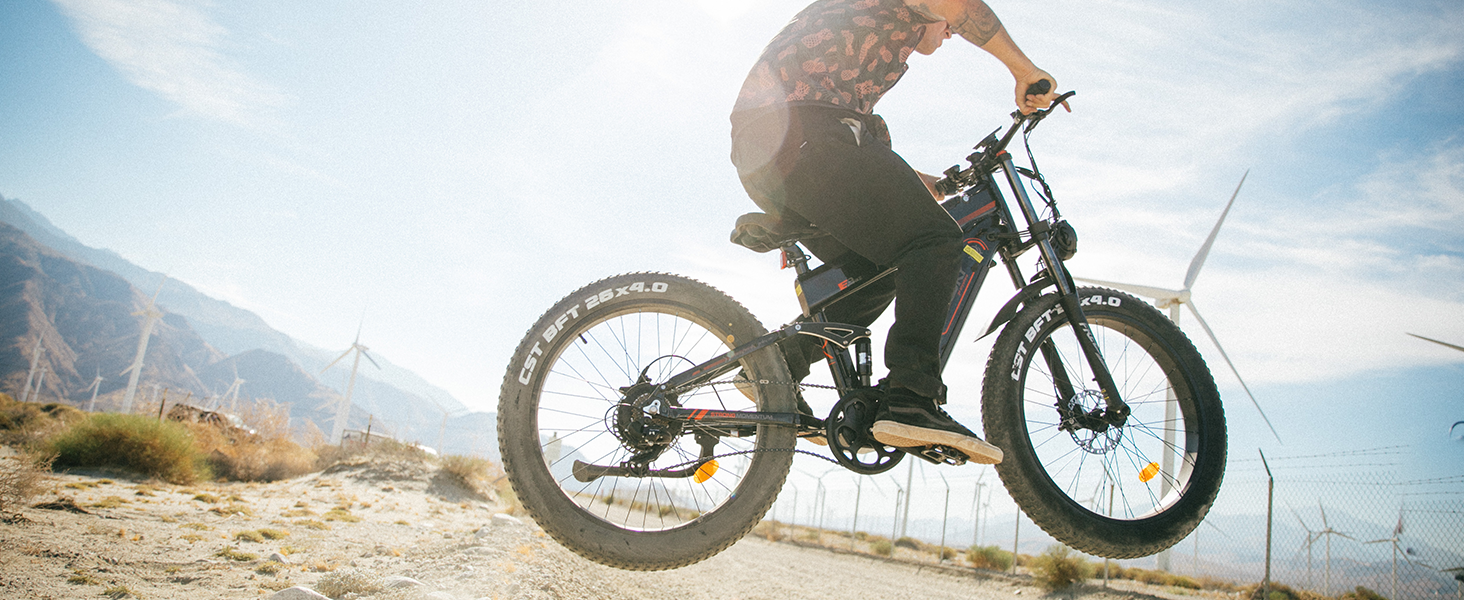
Alaska M-520 Electric Mountain Bike Comprehensive Guide
Apr 18, 2025 09:00
The Ultimate Choice for Off-Road AdventuresStep into the wild and dominate any terrain with the Alaska M-520, designed for peak performance and unmatched versatility. Equipped with dual batteries, the Alaska M-520 ensures long-lasting power for extended journeys. Whether you're traversing mountain trails, gliding over sandy beaches, or tackling city streets, this e-bike offers unparalleled performance and reliability. It’s the ultimate choice for outdoor enthusiasts who seek a bike that can handle it all, making every ride an adventure. Go Anywhere with AlaskaThe Alaska M-520 is engineered to handle diverse terrains with ease. From city roads to rugged trails and everything in between, this e-bike excels in every environment. Whether you're riding through urban landscapes, exploring dense forests, or climbing mountain paths, the Alaska M-520’s robust design and powerful motor provide the strength and durability you need. It's a perfect companion for long-distance riders and those who demand versatility from their e-bike. The Upgrade Dual Battery 48V 41AhGo the Distance with Dual EnergyWith dual removable batteries—18Ah on top and 23Ah below—the Alaska M-520 ensures you can go the distance. The advanced battery system delivers a remarkable range of 144-257 kilometers on a single 6-8 hour charge, depending on the terrain and power assist level. This makes the Alaska M-520 the ideal choice for long-distance riders, daily commuters, and outdoor adventurers who need reliable power for extended rides. Powerful Motor for High PerformanceRide Fast, Ride FearlessThe Alaska M-520 is powered by a high-performance motor that offers 130 N·m of torque, ensuring smooth acceleration and the ability to tackle steep hills with ease. Whether you're conquering challenging mountain paths, racing along sandy shores, or gliding over gravel trails, the Alaska M-520 provides the power you need to explore without limits. Its motor optimizes energy efficiency, helping to extend your ride while delivering consistent, reliable power across all terrains. Dual Suspension & Hydraulic Disc BrakesSmooth Rides and Safe StopsComfort and safety are key features of the Alaska M-520. Equipped with a lockable, adjustable front suspension hydraulic downhill fork and rear suspension, this e-bike ensures that you can ride for hours without feeling the impact of uneven terrains. The advanced suspension system absorbs shocks from bumpy roads, allowing for a smooth ride no matter where you go. The dual hydraulic disc brakes—on both front and rear wheels—offer powerful, responsive braking, ensuring you can stop safely even in the most challenging conditions. Smart LCD DisplayStay in control with the Alaska M-520's advanced LCD display. The smart display provides real-time feedback on key ride information, including your speed, remaining battery life, distance traveled, and the selected power assist mode. With five levels of pedal assist (PAS), you can easily adjust your ride to suit your needs, whether you prefer a relaxed cruise or a more intense workout. The display also includes key safety features like headlight status, making it easy to monitor your ride’s performance. UL2271 Certified BatterySafety is paramount, which is why the Alaska M-520 uses FREESKY’s UL2271 certified batteries. These batteries are rigorously tested to meet the highest safety standards, offering exceptional protection against both electrical and structural risks. The 41Ah(18Ah+23Ah) dual battery system allows you to cover impressive distances of up to 257 kilometers in pedal assist mode. Whether you're heading out for a long trail ride or commuting across town, you can trust that the Alaska M-520 will deliver consistent, reliable power. Thumb ThrottleFor easy acceleration, the Alaska M-520 is equipped with an ergonomically positioned thumb throttle. Simply press to unleash instant power and speed, allowing you to cruise effortlessly on flat terrain or boost up steep hills with minimal effort. This intuitive feature enhances the rider experience, giving you complete control over your speed. Rear Derailleur for Smooth ShiftingThe Alaska M-520 is equipped with a high-quality rear derailleur, ensuring that gear shifts are smooth and precise. Whether you’re climbing steep hills or cruising on flat roads, you can effortlessly change gears to maintain optimal performance. The reliable gear system ensures that you’re always prepared for any terrain. Rear SuspensionLong-distance rides are made more comfortable with the Alaska M-520’s rear suspension. Designed to absorb shocks from rough trails, it helps reduce strain on your body, ensuring that each ride is stable and comfortable. Whether you’re navigating rocky mountain paths or bumpy urban streets, the rear suspension will keep you in control. Front Suspension ForkThe adjustable front suspension fork is another key feature that enhances comfort and control. It minimizes vibrations and impacts, reducing fatigue on your arms and hands, even when riding over rough or uneven surfaces. This ensures that every ride, no matter the terrain, remains comfortable and under control. 4-Piston Hydraulic BrakesWhen it comes to safety, the Alaska M-520 doesn’t compromise. The 4-piston hydraulic disc brakes offer superior stopping power, making sure you can safely stop at a moment’s notice. Whether you’re riding downhill, through muddy trails, or on slippery surfaces, the brakes ensure smooth, controlled stopping power, giving you peace of mind during your adventures. Conclusion: A Versatile and Reliable Adventure BikeThe Alaska M-520 combines rugged performance, advanced technology, and exceptional comfort, making it the ultimate choice for off-road and urban riders alike. With its dual battery system, powerful motor, dual suspension, and high-end safety features, the Alaska M-520 ensures that every ride is smooth, safe, and exhilarating. If you're looking for a bike that can handle anything from mountain trails to city streets, the Alaska M-520 is your perfect companion. Ready to explore without limits? Take your adventure to the next level with the Alaska M-520. Check out the latest offer on the Alaska M-520! Alaska Pro M-520 Dual batteries, ultimate range performance.
Read More

Warrior Pro M-530 Electric Mountain Bike Comprehensive Guide
Apr 11, 2025 09:00
The Warrior Pro M-530 stands as a top-tier choice for adventurers seeking an e-mountain bike that offers the perfect combination of power, durability, and comfort. Engineered for rugged terrains and long-distance adventures, the Warrior Pro excels in both off-road challenges and city commuting. Whether you're exploring mountain trails or navigating city streets, this bike promises an unmatched experience, ensuring every ride is both thrilling and reliable. Designed for All-Terrain Conquerors The Warrior Pro M-530 excels in all environments, offering exceptional handling on a variety of terrains. From city roads to mountain trails and everything in between, this bike thrives where others struggle. Its powerful dual-motor system ensures smooth acceleration and consistent performance across the toughest surfaces, making it the perfect choice for those who demand versatility and reliability. Whether you're facing steep inclines, rocky paths, or sandy beaches, the Warrior Pro M-530 delivers a stable and exhilarating ride. Dual Motor Drive Mode: Double the Power, Double the Adventure Feel the power of dual hub motors in the front and rear wheels, each providing unmatched torque and smooth acceleration. With a combined torque of 200Nm, the Warrior Pro M-530 can easily conquer steep climbs, rough trails, and challenging off-road conditions. Thanks to the independently controlled motors, you have the flexibility to choose between single or dual motor mode, depending on your terrain and preference. This dynamic system ensures reduced motor strain, optimised energy efficiency, and a more enjoyable riding experience, whether you're tackling long-distance rides or steep uphill climbs. Dual Suspension for Maximum Comfort Equipped with a full suspension system, the Warrior Pro M-530 guarantees a smooth and comfortable ride, no matter the terrain. Featuring a lockable, adjustable front hydraulic downhill fork and rear suspension, this bike offers exceptional shock absorption. The result? Less impact from rough paths and a more stable ride. Whether you're navigating rocky trails or cruising through bumpy city streets, you’ll experience the comfort and control that comes with advanced suspension technology. Powerful and Reliable SAMSUNG 48V 30Ah Battery At the heart of the Warrior Pro M-530 lies its powerful 48V 30Ah SAMSUNG lithium battery, renowned for its durability and performance. The battery’s advanced BMS technology allows for a longer lifespan and more efficient energy management, ensuring you get the most out of every charge. With a full charge, you can enjoy a range of up to 96-152KM depending on motor usage and terrain. Whether you're cruising city streets or tackling rugged mountain trails, this battery will support long journeys without the need for frequent recharges. With just 10 hours of charging time, you can be ready for your next adventure in no time. Effortless Control with a Thumb Throttle The Warrior Pro M-530 is designed with rider comfort in mind. Its ergonomic thumb throttle ensures easy and natural control, allowing you to accelerate with minimal effort. Perfect for quick bursts of speed or maintaining a steady pace on flat terrain, this intuitive feature ensures that you’re always in charge of your ride. Precision and Performance with the Rear Derailleur Whether you're climbing hills or cruising down flat paths, the Warrior Pro M-530's rear derailleur offers smooth, precise shifting to ensure a smooth and efficient ride. With the ability to shift gears effortlessly, you’ll maintain optimal performance across all terrains. Whether you're navigating challenging mountain trails or commuting through the city, you’ll always have the control you need. Safety First: 4-Piston Hydraulic Brakes When it comes to safety, the Warrior Pro M-530 doesn't compromise. Equipped with 4-piston hydraulic brakes, this bike delivers exceptional stopping power, giving you confidence even in challenging conditions. Whether you're descending a steep hill or navigating through wet conditions, the Warrior Pro M-530 ensures quick, controlled stops for your safety. Built for the Future: Smart Features for the Modern Rider Stay connected and informed with the Warrior Pro M-530's advanced smart display. This cutting-edge system allows you to track your speed, battery level, and distance travelled, while providing easy access to intuitive settings. The NFC unlock feature adds an extra layer of convenience, letting you lock and unlock your bike with a simple tap. Conclusion: The Ultimate All-Terrain Adventure Bike The Warrior Pro M-530 is the epitome of power, performance, and versatility. With its dual-motor system, dual suspension, and cutting-edge technology, it’s the perfect companion for any adventure—whether you’re exploring challenging off-road trails or commuting through city streets. Thanks to its robust build, superior safety features, long-lasting battery, and exceptional range, the Warrior Pro M-530 ensures that every ride is a thrilling, comfortable, and efficient experience. Ready to explore without limits? Discover the Warrior Pro M-530 and elevate your riding experience to new heights.
Read More
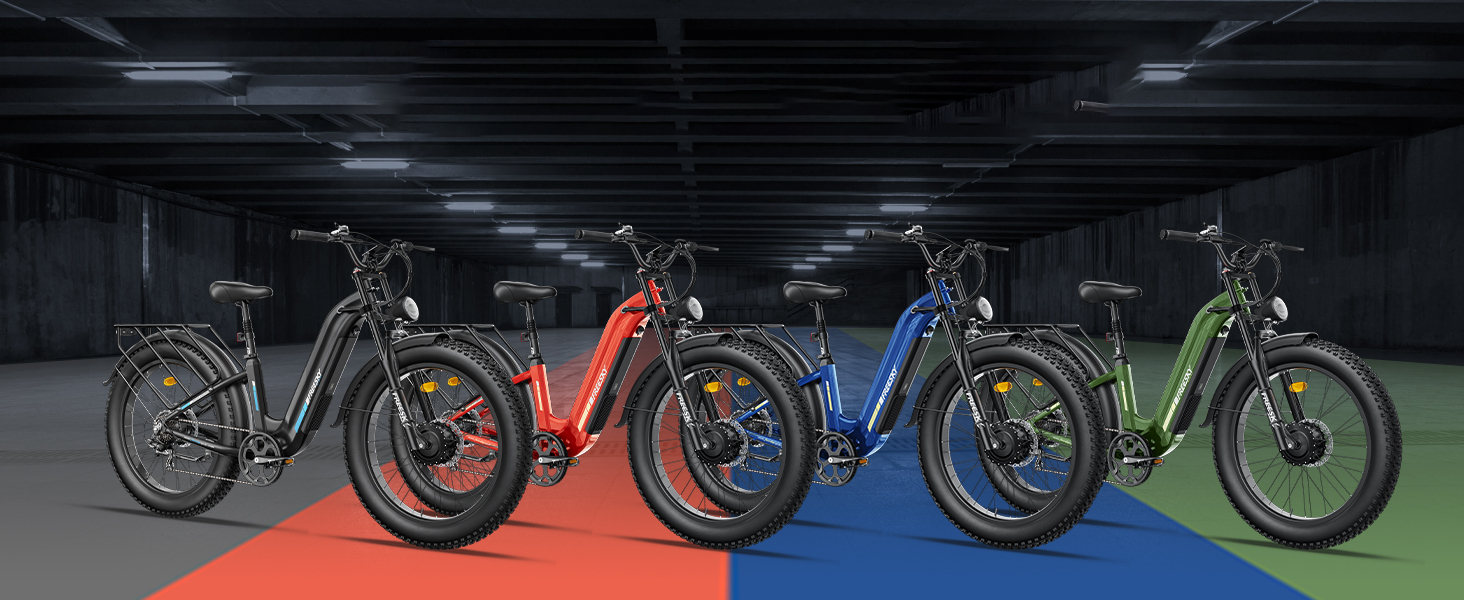
Introducing the Ranger M-540 Dual Motor All Terrain E-mountain Bike: Power, Performance, and Affordability
Apr 04, 2025 09:00
In the world of electric mountain bikes, few can match the balance of power, durability, and value offered by the Ranger M-540 Dual Motor All Terrain E-mountain Bike. As a new addition to the FreeskyCycle 2025 lineup, this cutting-edge e-bike is designed to handle diverse terrains and bring a thrilling, reliable experience to riders of all levels. Whether you're exploring rugged trails or commuting through your local countryside, the Ranger M-540 delivers the performance you need, without the premium price tag. Power, Performance, and Unbeatable Value The Ranger M-540 is engineered to offer an exhilarating ride with its dual motor system, ensuring robust assistance on even the steepest hills. Its powerful design allows for seamless transitions, making it an ideal companion for adventurous riders seeking to conquer all types of terrain. Thanks to its combination of dual motors and smart power management, the Ranger M-540 guarantees smooth acceleration and impressive speeds, no matter the environment. Unmatched Range and Battery Efficiency One of the standout features of the Ranger M-540 is its impressive range. Equipped with a high-capacity battery, this e-bike can reach distances of up to 96km on dual motor power, and 152km when running on a single motor. Whether you're out for a day of mountain biking or need a reliable option for your daily commute, the Ranger M-540 ensures you won’t be left stranded with its long-lasting battery. Superior Suspension and Comfort The front suspension fork and fat tyres of the Ranger M-540 make it perfectly suited for off-road adventures. Designed to smooth out bumps and absorb shocks from uneven surfaces, the suspension ensures a comfortable ride, even on the roughest trails. Whether you're cruising through rocky paths or navigating through muddy terrain, the Ranger M-540 maintains stability and control, providing the comfort needed for long rides. Enhanced Safety and Braking Performance When it comes to riding on challenging trails, safety is paramount. The Ranger M-540 is equipped with hydraulic disc brakes, ensuring reliable stopping power even in tough conditions. This means whether you're speeding downhill or stopping suddenly on rocky ground, you can trust the Ranger M-540 to keep you in control. Built for Adventure and Flexibility Designed for versatility, the Ranger M-540 is ideal for a range of outdoor activities, from mountain biking to family excursions. It can be easily adapted with accessories like child seats and cargo racks, allowing you to bring along extra gear or transport young riders. The aluminium frame is lightweight yet durable, making it easy to handle, while the low-step design ensures easy mounting and dismounting for riders of all experience levels. A Stylish and Practical Solution for Everyday Riders The Ranger M-540 doesn’t just perform well; it looks great too. With a sleek, modern design, it blends functionality with style. Whether you're commuting in the city or exploring off-the-beaten-path, the Ranger M-540's sleek finish and practical features make it a standout choice. The clear display screen provides easy access to key information such as battery level, speed, and distance, helping you stay informed on every ride. Limited Edition: Don’t Miss Out! As part of the FREESKY 2025 collection, the Ranger M-540 is a newly released model with limited stock available. This makes it an exclusive opportunity for e-bike enthusiasts looking to get their hands on one of the most affordable dual motor e-mountain bikes available. If you're looking for a bike that combines cutting-edge technology, exceptional performance, and unbeatable value, the Ranger M-540 is the bike for you. Check out the latest offer on the Ranger M-540! Ranger M-540 Dual-Motor Step-thru All-terrain E-mountain Bike.
Read More
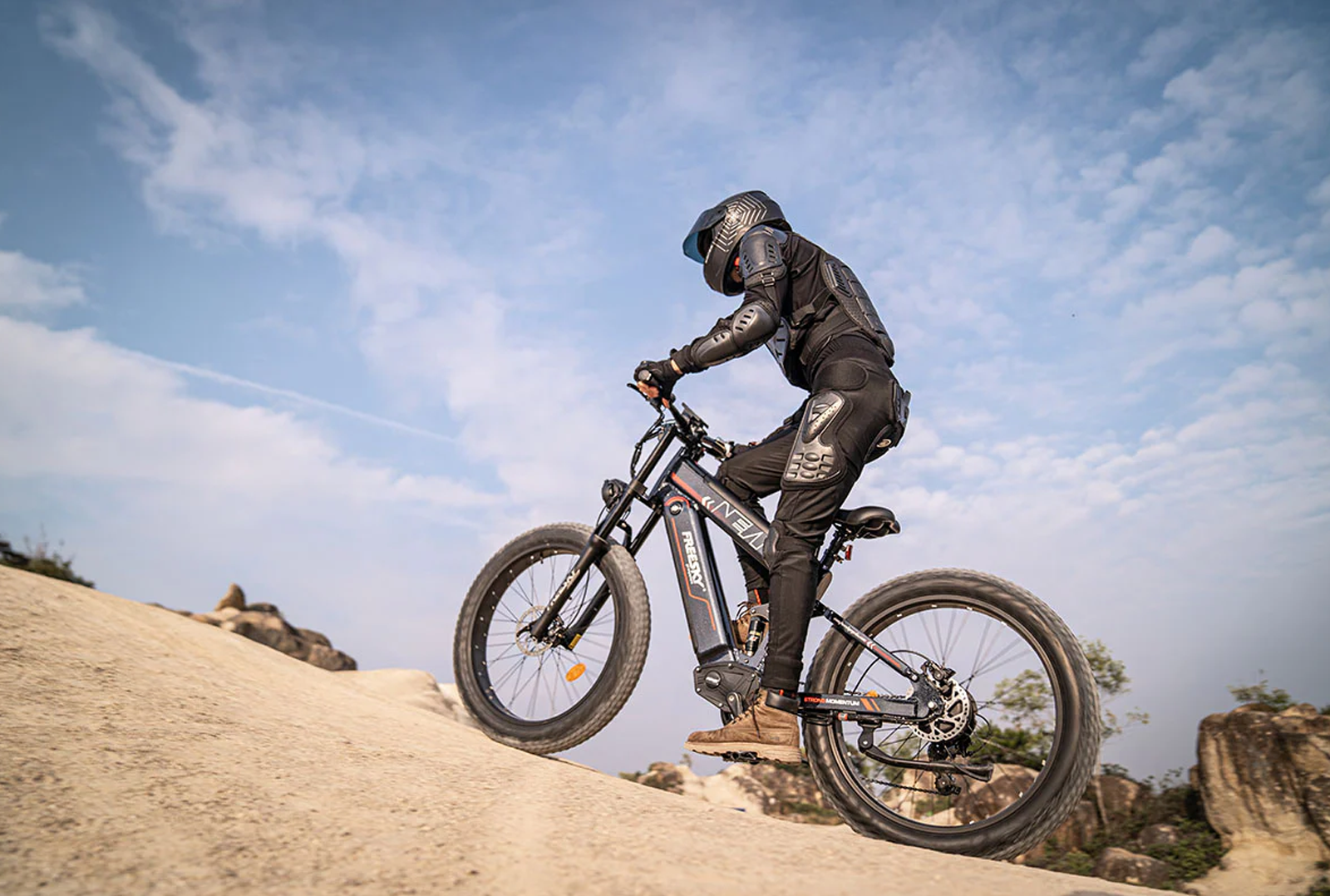
Can E-bikes Go Up Steep Hills? Exploring the Capabilities and Challenges
Mar 14, 2025 10:58
In the modern era of environmental consciousness and technological advancements, electric bikes, commonly known as e-bikes, have emerged as a popular mode of transportation. Their versatility, ease of use, and relative affordability have made them a favorite among commuters, fitness enthusiasts, and casual riders alike. However, the question remains: can e-bikes effectively conquer steep hills? This article aims to delve into this inquiry, examining the capabilities of e-bikes, the challenges they face on inclines, and the factors that influence their performance. To understand the ability of e-bikes to climb steep hills, it's essential to first grasp the fundamental principles behind their operation. E-bikes are equipped with an electric motor that provides additional power to the rider, either through a throttle or by assisting with pedal power. This motor is powered by a rechargeable battery, which determines the range and duration of the bike's electric assistance. The amount of power delivered by the motor can vary depending on the model and settings, ranging from a subtle boost to a significant push. When ascending a steep hill, the e-bike's motor must overcome the increased resistance caused by gravity. The steeper the incline, the greater the force required to ascend it. The performance of the e-bike on hills is influenced by several key factors, including the power of the motor, the capacity of the battery, the weight of the bike and rider, the gearing system, and the type of terrain. The power of the motor is a crucial determinant. High-powered motors are better equipped to handle steep inclines, providing sufficient torque to overcome the resistance. However, powerful motors also tend to consume more battery power, limiting the range of the bike. Conversely, lower-powered motors may struggle on steeper hills, especially when carrying heavier loads. The capacity of the battery is another essential factor. A larger battery can store more energy, allowing for longer periods of electric assistance. This is particularly important when climbing hills, as the motor may need to work harder and draw more power from the battery. Riders who frequently encounter steep hills may benefit from investing in a bike with a larger battery capacity. The weight of the bike and rider also plays a role. A heavier bike and rider require more energy to move, putting additional strain on the motor and battery. Lightweight e-bikes may have an advantage on hills, as they require less power to propel. The gearing system of the e-bike can also affect its hill-climbing capabilities. Similar to traditional bicycles, e-bikes often have multiple gears that allow riders to adjust the resistance when pedaling. Lower gears provide easier pedaling but slower speeds, while higher gears offer faster speeds but require more effort. Riders ascending hills may find it beneficial to shift to lower gears, reducing the amount of work required to pedal and relying more on the motor's assistance. Terrain conditions can also influence the performance of e-bikes on hills. Loose soil, gravel, or slippery surfaces can reduce traction and make climbing more challenging. Riders should be aware of the conditions they are riding in and adjust their approach accordingly, such as reducing speed or taking alternative routes. Despite these challenges, e-bikes are capable of climbing steep hills with varying degrees of success. The key is to choose a bike that is suitable for the rider's needs and the terrain they encounter. Riders may need to experiment with different settings and techniques to find the optimal balance between motor assistance and pedal power. Additionally, regular maintenance and proper care of the e-bike, such as keeping the battery charged and the motor clean, can help ensure optimal performance. It's worth noting that not all e-bikes are designed for off-road or steep hill climbing. Some models are specifically tailored for urban commuting or casual riding on flat terrain. Riders interested in conquering steep hills should research and compare different models to find one that is suitable for their intended use. In conclusion, the ability of e-bikes to climb steep hills depends on a variety of factors, including the power of the motor, the capacity of the battery, the weight of the bike and rider, the gearing system, and the terrain conditions. With careful selection and proper usage, e-bikes can be a viable option for riders who need to ascend steep inclines. However, riders should be aware of the limitations of their bike and adjust their approach accordingly to ensure a safe and enjoyable ride.
Read More